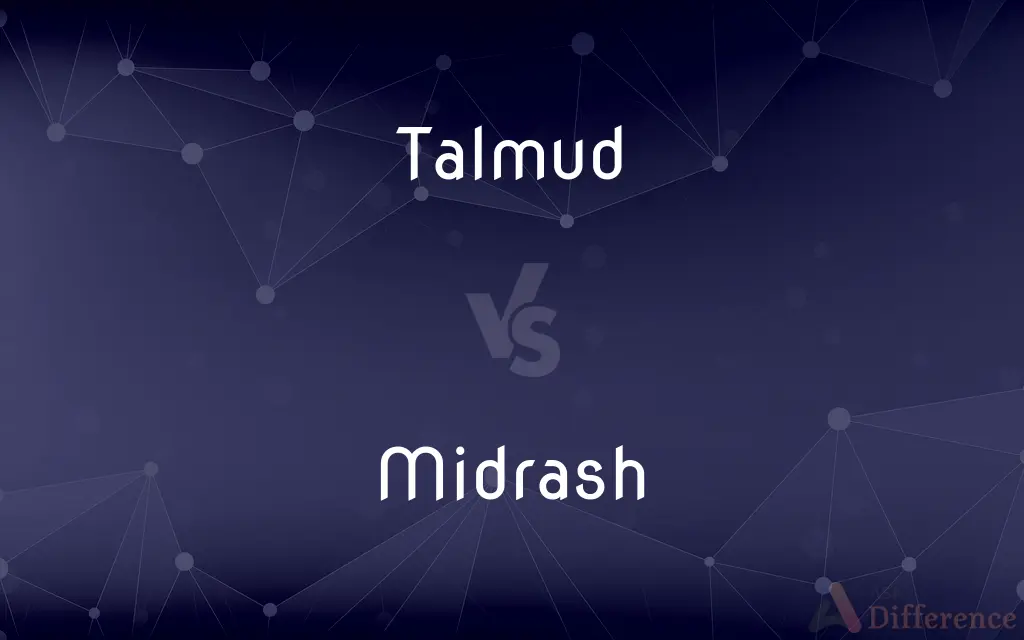Talmud vs. Midrash — What's the Difference?
By Urooj Arif & Maham Liaqat — Updated on April 7, 2024
The Talmud is a central text of Rabbinic Judaism, comprising the Mishnah and the Gemara, focusing on Jewish law and tradition. Midrash encompasses rabbinic literature that interprets, or provides commentary on the Hebrew Bible, through storytelling.

Difference Between Talmud and Midrash
Table of Contents
ADVERTISEMENT
Key Differences
The Talmud, central to Rabbinic Judaism, is a comprehensive compilation of Jewish oral law, ethical teachings, and traditions. It consists of two parts: the Mishnah, a written collection of oral laws compiled around 200 CE, and the Gemara, a commentary on the Mishnah, elaborating on its teachings and laws, completed in two editions, the Babylonian Talmud (circa 500 CE) and the Jerusalem Talmud (circa 400 CE). Midrash, on the other hand, represents a genre of rabbinic literature that includes commentary on the Hebrew Bible, aiming to explain and interpret biblical texts, often filling in gaps or resolving ambiguities found in scripture. Midrashic texts employ various methods, including allegory, analogy, and storytelling, to explore themes and lessons within the Bible, making them accessible and relevant to everyday life.
The Talmud is foundational for understanding Jewish law (Halacha), customs, and ethical guidelines, serving as a guide for daily living and religious practice. While some Midrashim (plural for Midrash) focus on legal interpretation (Halakhic Midrash), others are more concerned with narrative and ethical insights (Aggadic Midrash).
While the Talmud is primarily legalistic, focusing on laws and their application, Midrash tends to be more narrative, offering insights into the biblical text that go beyond the legal framework. For instance, the Talmud might discuss the practical application of a biblical law, while Midrash might tell a story that illustrates the moral or spiritual lessons derived from that law.
Both the Talmud and Midrash are crucial for understanding Jewish thought, theology, and practice. The Talmud serves as the backbone of Jewish legal and ethical thought, whereas Midrash provides a deeper, often more personal connection to the biblical text, enriching the spiritual and moral life of Jewish communities.
The study of the Talmud and Midrash in Jewish tradition is not just an academic exercise but a spiritual and moral pursuit. Through Talmud study, Jews engage with centuries of debate and discussion on how to live a life aligned with divine will. Through Midrash, they explore the richness of biblical stories and commandments, seeking deeper spiritual meanings and connections to God.
ADVERTISEMENT
While the Talmud focuses on the legal and practical aspects of Jewish life, Midrash explores the ethical, moral, and narrative dimensions of the Hebrew Bible. Both are essential for a full understanding of Jewish tradition, law, and ethics, each complementing the other by addressing different facets of Jewish religious life and thought.
Comparison Chart
Nature
A comprehensive collection of Jewish law and ethics.
A genre of rabbinic literature focusing on biblical interpretation.
Components
Mishnah and Gemara.
Halakhic and Aggadic texts.
Focus
Legal discussions and ethical teachings.
Biblical commentary and storytelling.
Purpose
To guide daily living and religious practice.
To explore themes and lessons within the Bible.
Method
Analytical discussion and legal reasoning.
Allegory, analogy, and narrative.
Significance
Central to Rabbinic Judaism and Jewish legal thought.
Enriches spiritual and moral understanding of the Bible.
Usage
Studied for religious law (Halacha) and ethical guidelines.
Used for theological insight and moral instruction.
Compare with Definitions
Talmud
Jewish oral law and tradition.
The Talmud discusses the details of Sabbath observance.
Midrash
Rabbinic commentary on the Bible.
Midrash Rabbah explores Genesis stories.
Talmud
Analytical and legal reasoning.
Talmudic debates clarify legal principles.
Midrash
Uses allegory and narrative.
Midrash interprets Abraham's journeys allegorically.
Talmud
Comprises Mishnah and Gemara.
Gemara comments on Mishnah's teachings.
Midrash
Enhances biblical understanding.
Midrash explains the significance of Moses' speech impediment.
Talmud
Guide for daily living.
The Talmud addresses dietary laws and prayer.
Midrash
Includes legal and ethical insights.
Midrashim provide context for commandments.
Talmud
Central to Rabbinic Judaism.
Talmud study is pivotal in yeshiva education.
Midrash
Connects text to daily life.
Midrash offers lessons from King David's leadership.
Talmud
The Talmud (; Hebrew: תַּלְמוּד Tálmūḏ) is the central text of Rabbinic Judaism and the primary source of Jewish religious law (halakha) and Jewish theology. Until the advent of modernity, in nearly all Jewish communities, the Talmud was the centerpiece of Jewish cultural life and was foundational to "all Jewish thought and aspirations", serving also as "the guide for the daily life" of Jews.The term "Talmud" normally refers to the collection of writings named specifically the Babylonian Talmud (Talmud Bavli), although there is also an earlier collection known as the Jerusalem Talmud (Talmud Yerushalmi).
Midrash
Midrash (; Hebrew: מִדְרָשׁ; pl. מִדְרָשִׁים midrashim) is expansive Jewish Biblical exegesis using a rabbinic mode of interpretation prominent in the Talmud.
Talmud
The collection of ancient Rabbinic writings consisting of the Mishnah and the Gemara, constituting the basis of religious authority in Orthodox Judaism.
Midrash
Any of a group of Jewish commentaries on the Hebrew Scriptures compiled between AD 200 and 1200 and based on exegesis, parable, and haggadic legend.
Talmud
The body of the Jewish civil and canonical law not comprised in the Pentateuch.
Midrash
A talmudic exposition of the Hebrew law, or of some part of it.
Talmud
The collection of ancient rabbinic writings on Jewish law and tradition (the Mishna and the Gemara) that constitute the basis of religious authority in Orthodox Judaism
Common Curiosities
Why are both the Talmud and Midrash important in Jewish education?
They offer comprehensive insights into Jewish law, ethics, and spirituality, enriching the religious and moral life of the community.
Is the Talmud universally accepted in Judaism?
While central to Rabbinic Judaism, different Jewish communities may emphasize Talmud study to varying degrees.
Can Midrash be found within the Talmud?
Yes, Aggadic Midrash, or narrative commentary, appears within the Talmud, blending legal discussion with ethical and spiritual insights.
How is the Talmud organized?
The Talmud is organized into tractates, each focusing on a specific area of Jewish law, discussed through Mishnah and Gemara.
How do scholars study Midrash?
Scholars study Midrash by analyzing its literary forms, historical context, and theological themes.
How do the Talmud and Midrash complement each other?
The Talmud provides the legal framework for Jewish life, while Midrash enriches understanding of biblical texts and commandments with narrative depth.
What is the primary difference between the Talmud and Midrash?
The Talmud focuses on Jewish law and tradition, while Midrash provides commentary on the Hebrew Bible through narrative and allegory.
Are there different types of Midrash?
Yes, there are Halakhic Midrashim, focusing on legal interpretation, and Aggadic Midrashim, which explore narrative and ethical teachings.
What role does storytelling play in Midrash?
Storytelling in Midrash illuminates the ethical and spiritual dimensions of biblical texts, making them relevant to contemporary life.
What is the significance of the Babylonian Talmud compared to the Jerusalem Talmud?
The Babylonian Talmud is more extensive and widely studied in Jewish tradition than the Jerusalem Talmud, reflecting a broader range of discussion and interpretation.
Share Your Discovery

Previous Comparison
Conservative vs. Radical
Next Comparison
Traceable vs. TrackableAuthor Spotlight
Written by
Urooj ArifUrooj is a skilled content writer at Ask Difference, known for her exceptional ability to simplify complex topics into engaging and informative content. With a passion for research and a flair for clear, concise writing, she consistently delivers articles that resonate with our diverse audience.
Co-written by
Maham Liaqat













































